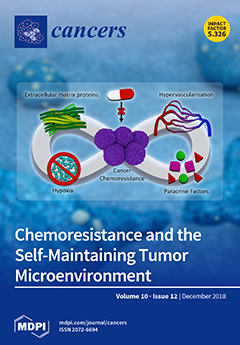Forty percent of non-small cell lung cancer (NSCLC) patients develop brain metastases, resulting in a dismal prognosis. However, patients in an oligo-metastatic brain disease setting seem to have better outcomes. Here, we investigate the possibility of using circulating tumor cells (CTCs) as biomarkers to differentiate oligo-metastatic patients for better risk assessment. Using the CellSearch
® system, few CTCs were detected among NSCLC patients with brain metastases (
n = 52, 12.5% ≥ two and 8.9% ≥ five CTC/7.5 mL blood) and especially oligo-metastatic brain patients (
n = 34, 5.9%, and 2.9%). Still, thresholds of both ≥ two and ≥ five CTCs were independent prognostic indicators for shorter overall survival time among all of the NSCLC patients (
n = 90, two CTC ≥ HR: 1.629,
p = 0.024, 95% CI: 1.137–6.465 and five CTC ≥ HR: 2.846,
p = 0.0304, CI: 1.104–7.339), as well as among patients with brain metastases (two CTC ≥ HR: 4.694,
p = 0.004, CI: 1.650–13.354, and five CTC ≥ HR: 4.963,
p = 0.003, CI: 1.752–14.061). Also, oligo-brain NSCLC metastatic patients with CTCs had a very poor prognosis (
p = 0.019). Similarly, in other tumor entities, only 9.6% of patients with brain metastases (
n = 52) had detectable CTCs. Our data indicate that although patients with brain metastases more seldom harbor CTCs, they are still predictive for overall survival, and CTCs might be a useful biomarker to identify oligo-metastatic NSCLC patients who might benefit from a more intense therapy.
Full article






